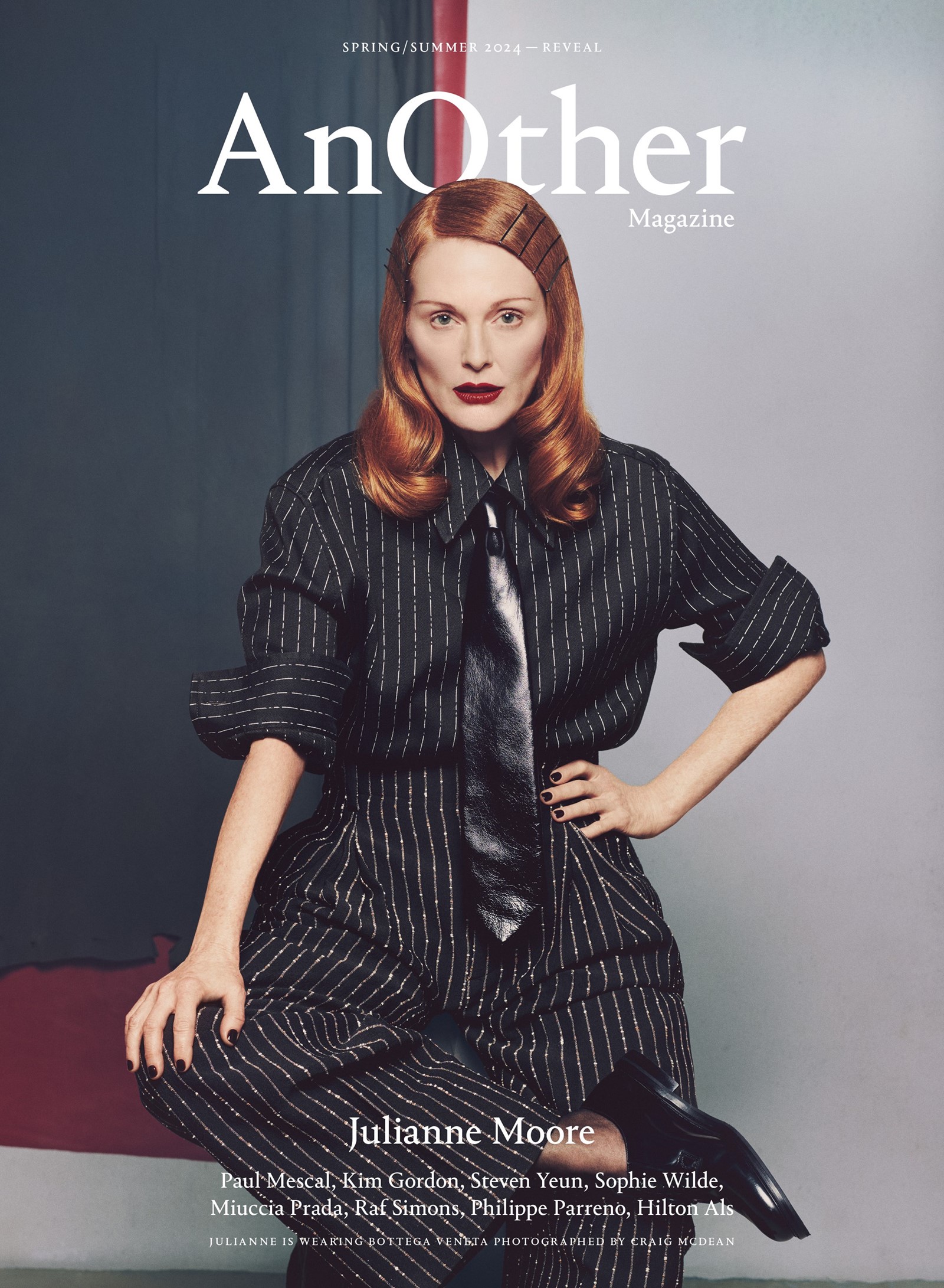This article is taken from the Spring/Summer 2024 issue of AnOther Magazine:
Soap addicts of 1980s America knew Julianne Moore as Frannie Hughes, the bouncy-fringed ingenue with a disastrous love life in As the World Turns. On weekday afternoons she was tangled in plotlines that encompassed being kidnapped by a homicidal fiancé and battling an evil British twin. With sheaves of rapidly written dialogue and barely time for two takes, that stint on daytime television at the CBS studios in Hell’s Kitchen was a small-screen bootcamp for Moore and the incongruous flipside to her nightlife off-Broadway in the likes of Caryl Churchill’s skewering of Eighties greed, Serious Money. The actor had arrived in New York in 1983 with a theatre degree from Boston University, a laser focus and a sideline in magical thinking: her morning ritual at the time, christened “the lucky way”, involved leaving her apartment at precisely the same moment each day and adjusting her gait so she never waited at a traffic light. There were no downtown clubs or aftershow parties. She mastered her lines, forced herself to watch her performances for hairline cracks and excelled, picking up an Emmy for the soap and lauded work onstage. Yet one thing eluded Moore: she couldn’t make a dent in the film business. “There were all these big, splashy, commercial movies in the Eighties, and I just didn’t get them,” she says today, spooning honey into her tea as we sit in the leather booth of a bistro near Washington Square Park, the fireplace lit against a darkening afternoon. “I figured maybe it wasn’t going to happen for me. I just could not get a film.”
Today Moore is the versatile queen of that medium. Acting opposite her is, as Mark Ruffalo once put it, “like sharing the court with Michael Jordan”. In the four decades since her debut, the 63-year-old has played glassy-eyed porn stars and incestuous heiresses, ziplining artists and viperous blackmailers, housewives stifled in suburbia and dystopian presidents corrupted by power. She has embodied real women, from the feminist icon Gloria Steinem to the red-meat Republican Sarah Palin – transcending the punch lines and nailing the latter’s folksy vernacular. “All of them are close to me,” she says, refusing to choose between them. “I’m only using myself or what I’ve observed.” Those razor powers of observation make her a master at peeling away the artifice to reveal our true selves in all our flaws and messiness – the petty cruelties and crumpled aspirations, the quotidian grind and flashes of joy. Whether she’s suppressing unwieldy feelings under a minutely rippling surface or her face is soggy with tears (no one silent-cries, choke-sobs or all-out wails like Moore can) she has the kind of screen presence that makes an audience hold their collective breath. And while she’s done her share of big-budget action – she has co-starred with a mother and baby T-rex and hunted a brain-eating psychopath – Moore has always seemed more interested in navigating psychological riptides than voyaging into actual stormy seas. “Oh God, I’m not an adventure-tales person,” she says. “I don’t care if they get on a boat and sail across the ocean. I want stories about relationships and families. Human drama.”
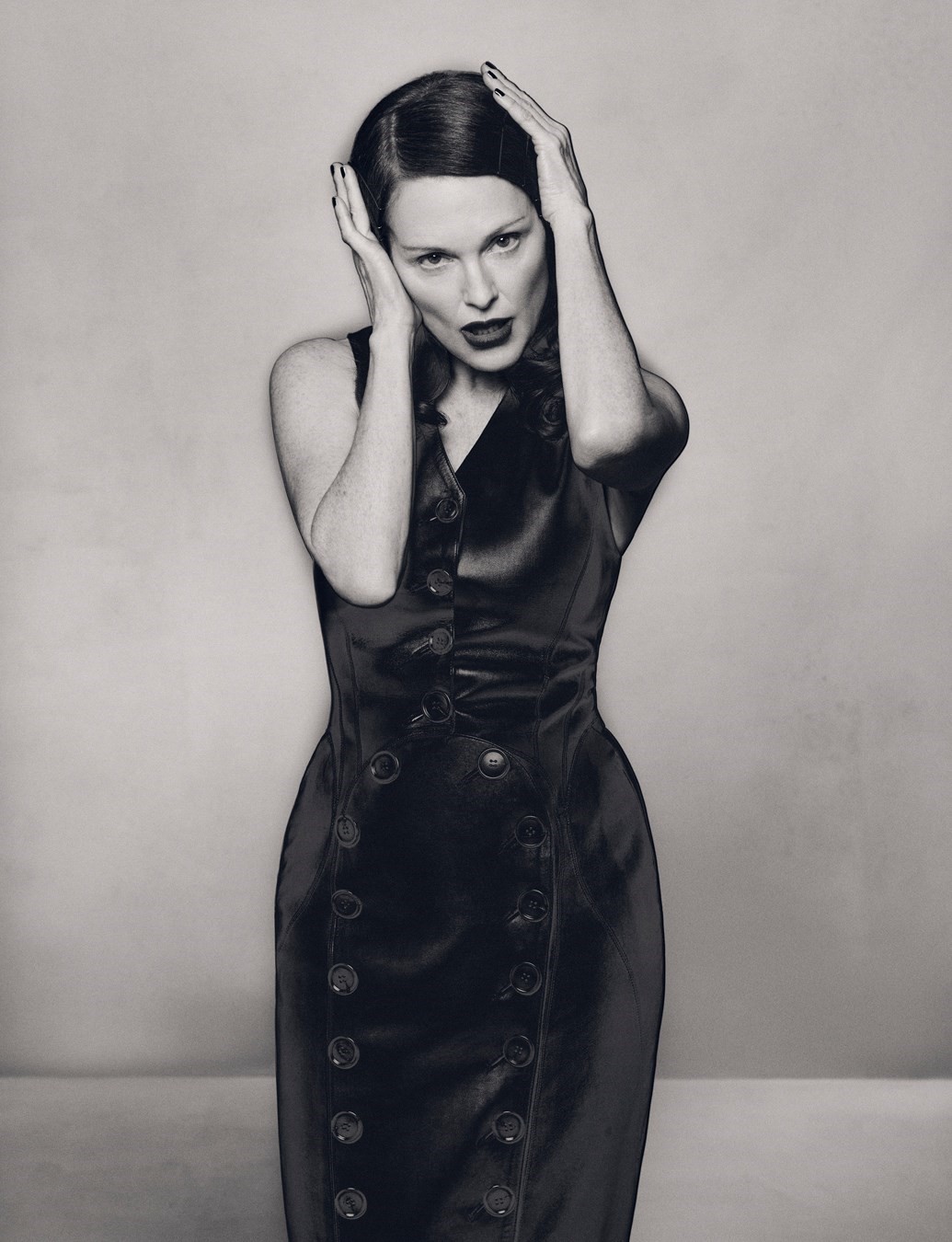
It took the most deliberately uncommercial project imaginable to light the fuse on Moore’s big-screen career. In 1990, the year she turned 30, the theatre maverick André Gregory recruited her into an elite troupe of players who workshopped Chekhov’s riddle of doom and desire, Uncle Vanya, in living rooms downtown. They never played it the same way twice and made a pact not to perform it for an audience. “That informed my work more than anything else has,” she says. “I learnt that by being awake and aware the scene would surprise you, it would take you along with it. It changed me and my process entirely.” A few years in, the group loosened their no-audience rule and took over an abandoned Times Square theatre, formerly a seedy burlesque hall and later a triple-X-rated grindhouse. In a decaying space that vibrated to the rumble of the 42nd Street subway, they began inviting select friends to watch their take on Russian fin-de-siècle malaise rewired for Nineties New York City. One evening Moore found herself playing her mercurial Yelena for Mikhail Baryshnikov, another under the merciless gaze of Susan Sontag. But it was the veteran one-off behind free-wheeling treasures like Nashville and The Player, Robert Altman, who showed up and moved the needle for Moore. He offered her the role of an adulterous painter in his sprawling 1993 drama Short Cuts, stitched out of nine Raymond Carver stories transplanted from the Pacific Northwest to a curdled Nineties LA. The plot orbits around 22 soul-sick Angelenos interlinked by chance on the city’s rackety edges – grubby diners, trailer parks, tumbleweed nightclubs – with a mosaic cast that includes Robert Downey Jr, Tim Robbins, Tom Waits and Jennifer Jason Leigh. But it was Moore who got the headlines for the delicate shades of a five-minute monologue that shifts from domestic platitudes to fidgety unease to a furious firework of a confession – all delivered while naked from the waist down. It was the perfect concoction of prodigious skill and press-friendly soundbite, fixing her in Tinseltown’s imagination and winning her and the cast a joint Golden Globe. (Legions more accolades were to come; as her friend Ethan Hawke has said, “You don’t know how many awards you haven’t won until you Google ‘Julianne Moore’.”)
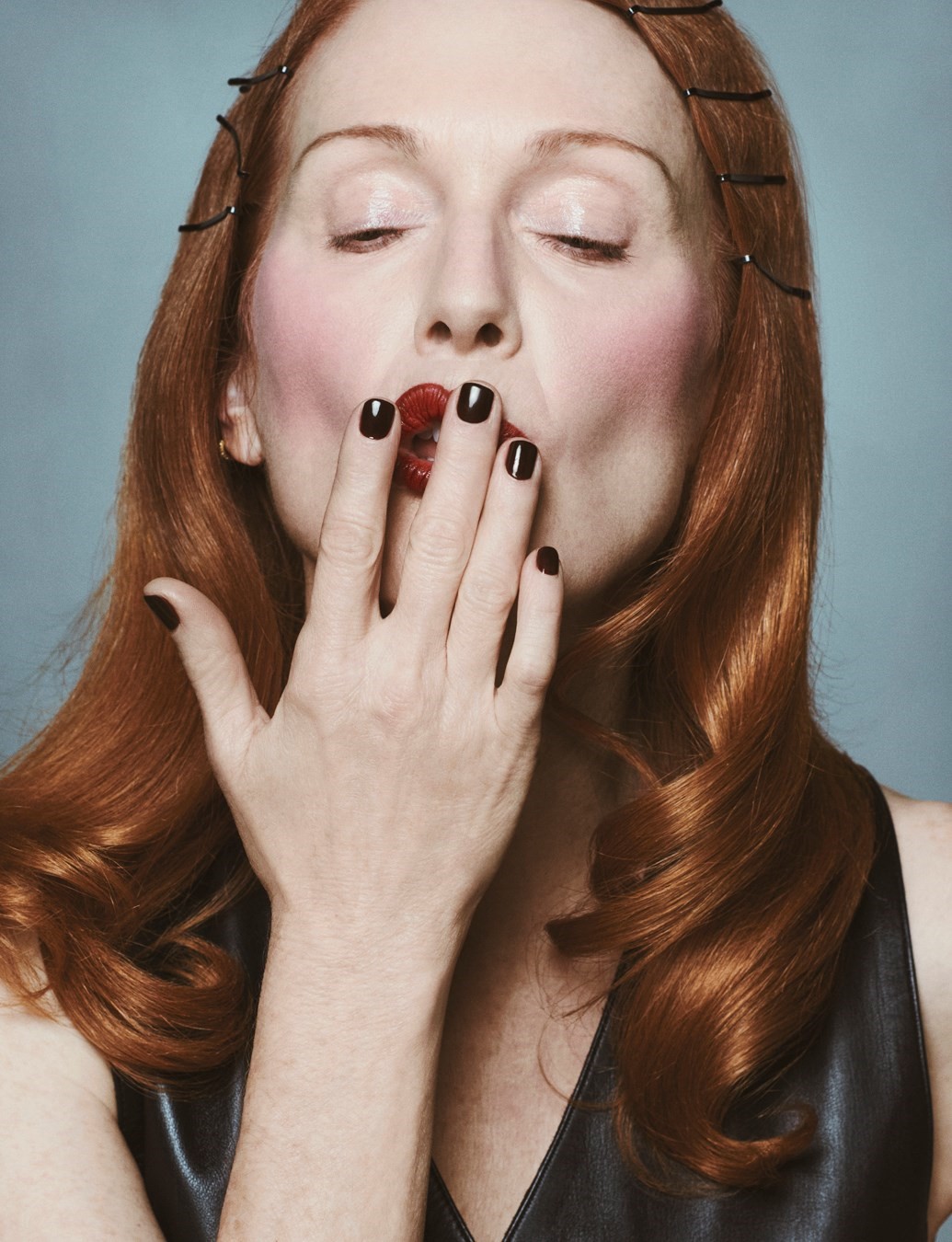
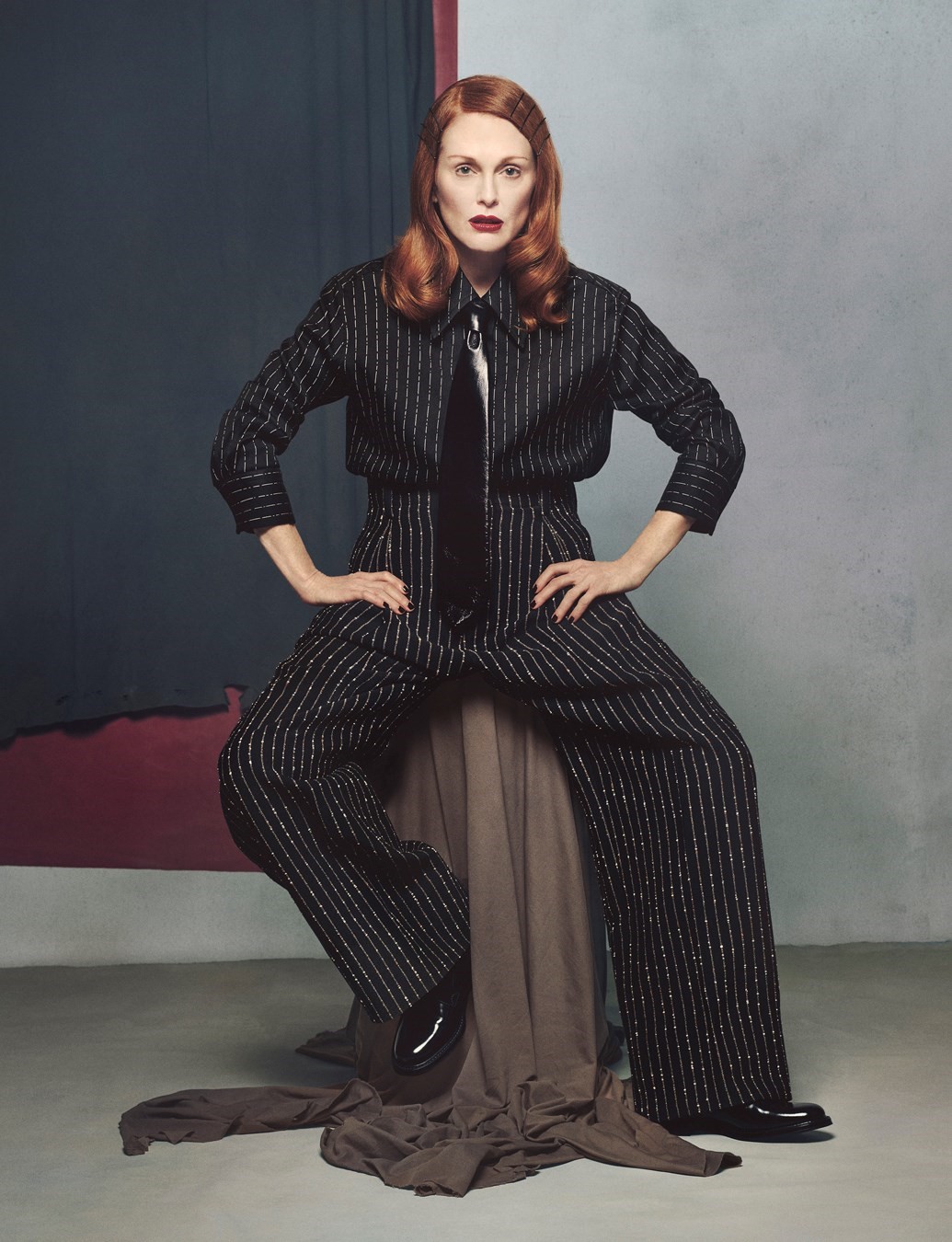
That Altman was the orchestrator of Moore’s breakthrough felt something like fate. “Bob was the person who made me want to be a film actor long before I met him,” she says. “At Boston University I started going to revival houses – I watched David Lynch’s Eraserhead and John Waters films, discovered foreign films by Truffaut and Godard and Fassbinder. And then one night I saw Bob’s 3 Women and for the first time I really noticed a directorial voice – I could feel what he was doing. I was completely fascinated by those three actors – Sissy Spacek, Shelley Duvall and Janice Rule. It woke me up. I thought, ‘That is the work I want to do.’”
That work was not showing up at the multiplexes of the Eighties – and the multiplexes of the Eighties didn’t know what to do with an actor like Moore. But as that decade drew to a close, more uncompromising visions were beginning to take root in Park City, a backwater ski resort circled by mountains in Utah. Against a climate of escalating turmoil in the US – the Aids crisis and Reagan’s negligent response, the tinderbox of racial and socioeconomic tensions in LA – the scrappy, shoestring films playing at Sundance Film Festival were capturing the spirit of the times in a way the mainstream wasn’t. Its snowbound Main Street became a hotbed of aspiring auteurs and enfants terribles: Gregg Araki, Paul Thomas Anderson, Quentin Tarantino, Lisa Cholodenko, the Coen brothers. And, most significantly for Moore, the art graduate Todd Haynes, whose career opener was the still-banned but widely bootlegged biopic Superstar: The Karen Carpenter Story, which used Barbie dolls on miniature cardboard sets to enact the life and tragic death of that singer of flugelhorn-heavy hits.
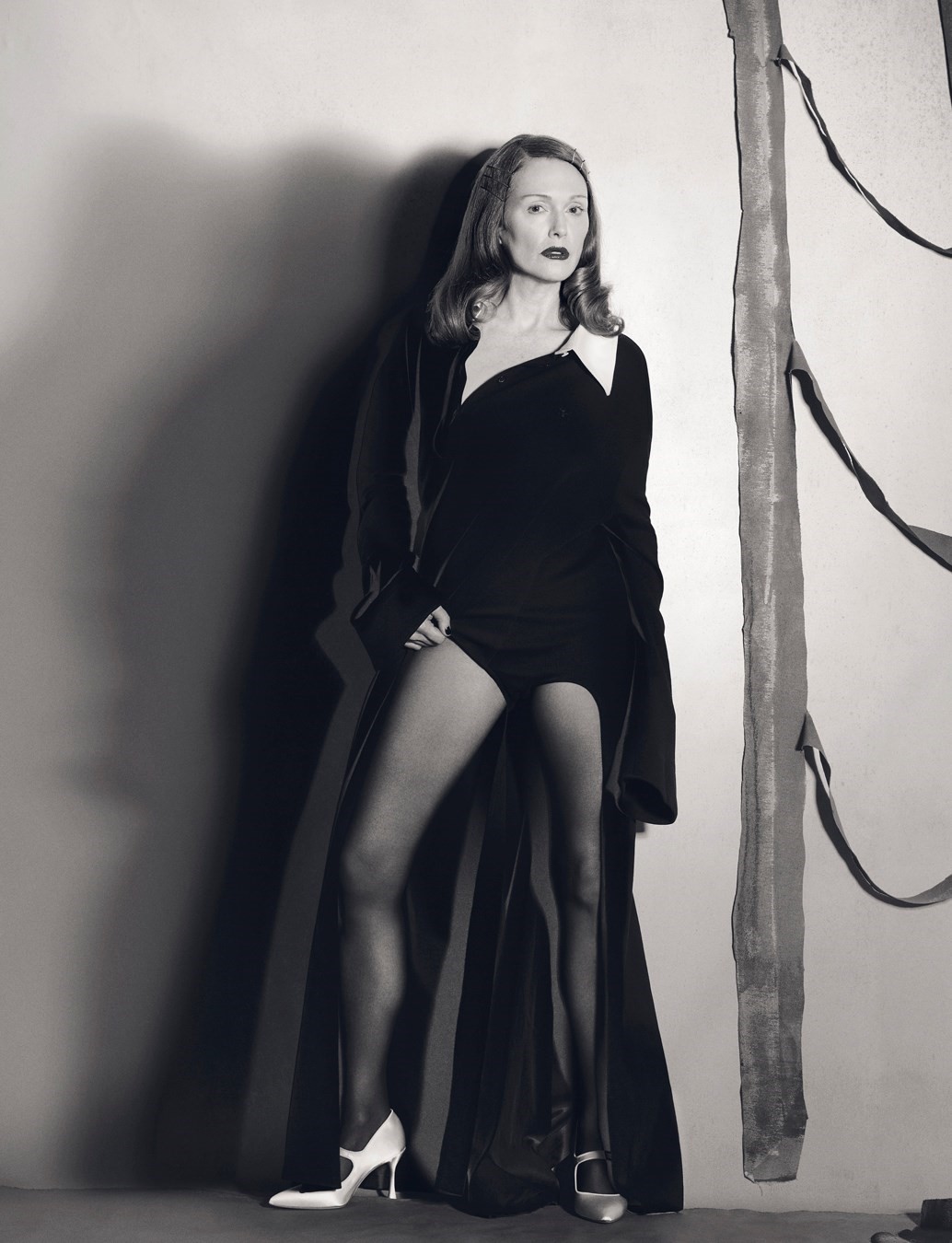
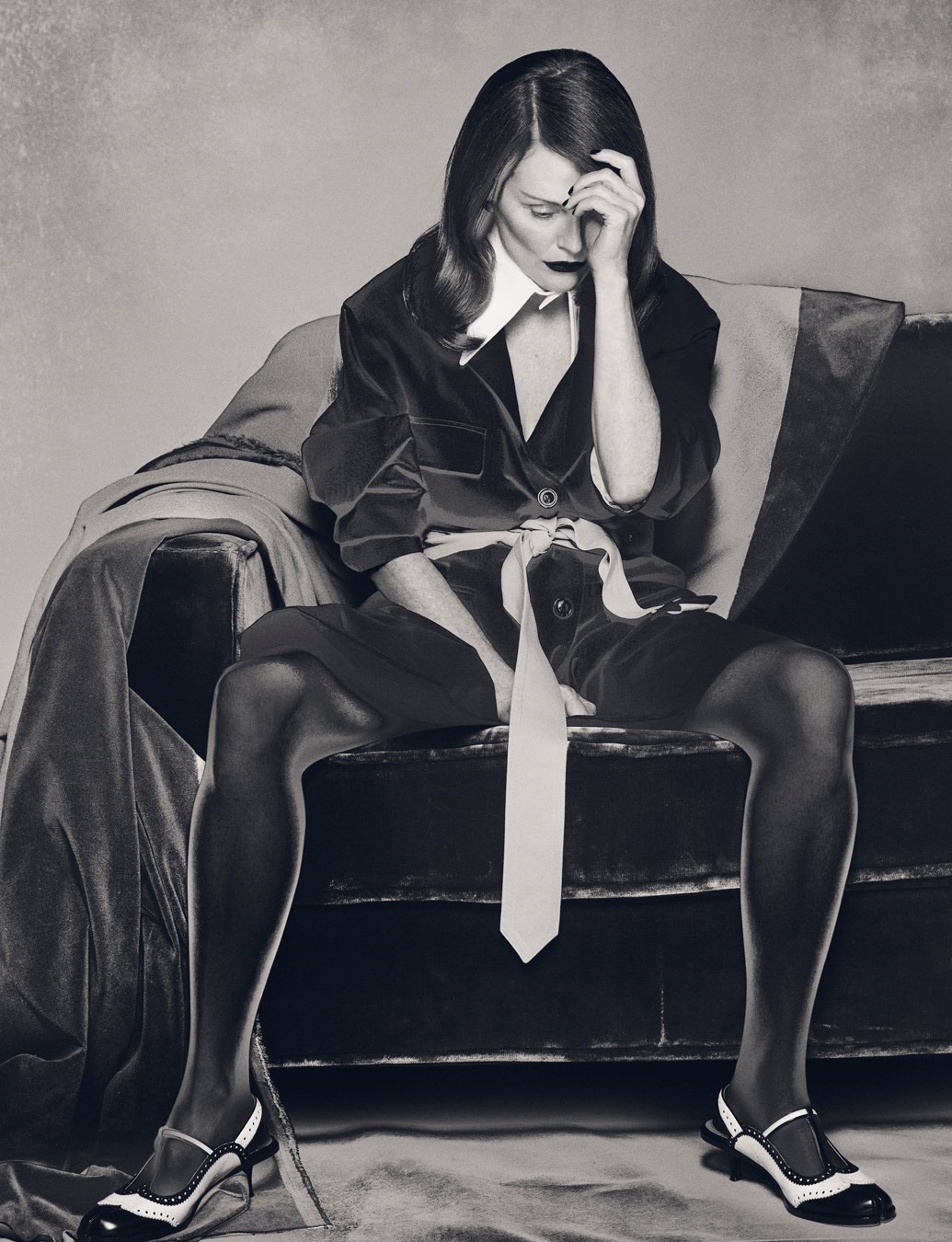
Haynes had seen an early edit of Short Cuts; his producer Christine Vachon had noticed Moore in the killer-nanny thriller The Hand That Rocks the Cradle as the witty, chain-smoking friend whose gory murder in a shower of booby-trapped greenhouse glass was hard to miss. (Many notable film deaths have followed: Moore has been killed by tuberculosis, heroin and nuclear explosion, impaled by bow and arrow, slayed by telekinetically controlled kitchen utensils and bludgeoned to death with a Genie award. “Your characters are always dying or they’re getting divorced,” her daughter, Liv, once complained.)
They sent Moore the script for Safe, Haynes’s deeply unsettling parable of late-capitalist alienation, soundscaped by doomy traffic reports, religious talk radio and the tinnitus buzz of domestic machinery. The film’s protagonist, Carol White, is a disintegrating Californian housewife who becomes allergic to the modern material world. As she drifts through aerobics classes, baby showers, fruit diets and domestic errands in a somnolent San Fernando Valley, she appears to be slowly poisoned by unseen toxins her wrought-iron gates can’t keep at bay – exhaust fumes and aerosols, hair products and particulates. Pointedly set in the dog days of Reagan’s neoliberalism, it’s a horror film that is haunted by the Aids and climate crises, monsters that are everywhere and nowhere. “I’d never read anything like it before,” Moore says, her finely carved features lighting up. “It was so spare, the language was so exacting, the subject matter was absolutely arresting and I couldn’t believe it wasn’t cast – why is somebody famous not doing this? I was desperate to get it.”
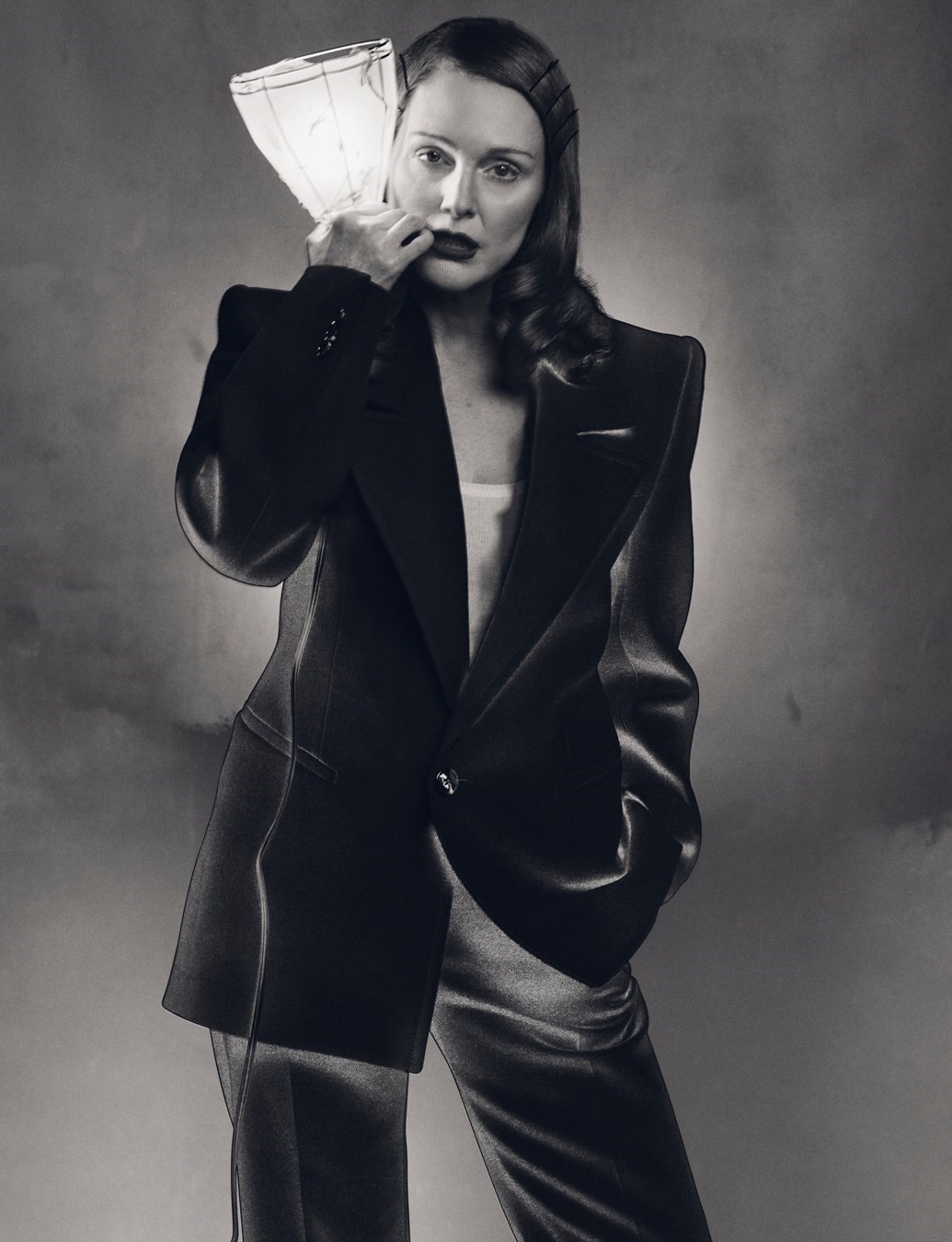
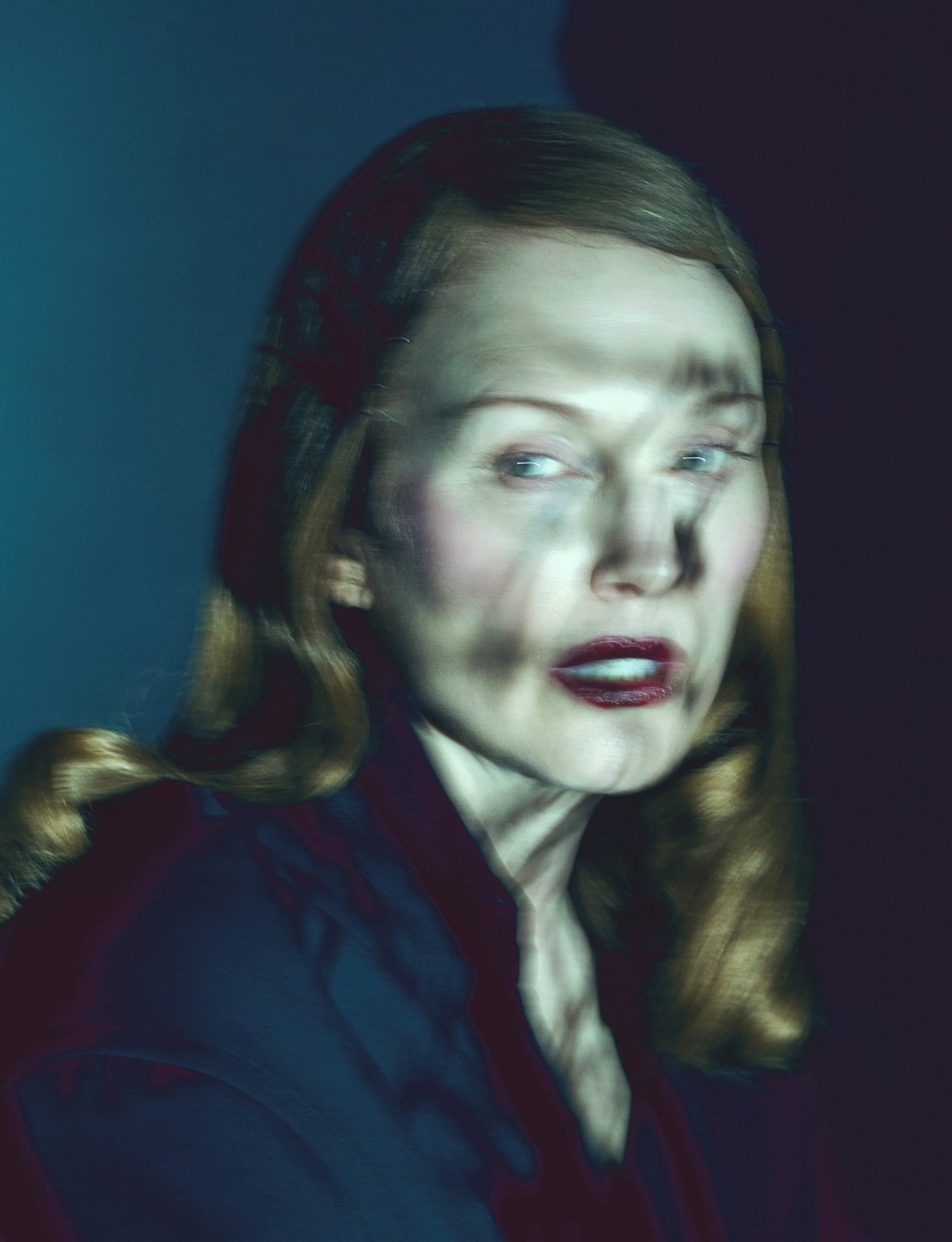
She was shooting a family comedy in Pittsburgh at the time. “But I flew myself home on a weekend to read for Todd. I wore white jeans and a white T-shirt because I wanted Carol to look wiped out. I had this idea about her that was very specific, and I thought, ‘If it’s not what he wants I’m the wrong person, because I can only see it like this.’” In the grainy footage that exists of her audition in a cluttered SoHo office, she pitches her voice high and tinny as though it’s removed from her body, a question mark hovering over each petering sentence. When Moore left the room after reading three scenes, she’d landed her first starring role. Many actors might have smuggled some flashiness into their big break, but Moore committed absolutely to Haynes’s concept of Carol as a milky-pale cipher, diluting herself so thoroughly she vanishes into the antiseptic decor of her faux-Tudor mansion. “I’m not so interested in my own isolated performance,” she says. “I want to be inside the director’s story.”
Initially received as an artful curiosity when it was released in 1995, Safe is today considered a disturbing masterpiece, its prescient vision inching closer every year. It was a feat made even more impressive for its ill-starred production: “The Northridge earthquake happened in the middle of it,” Moore says. “We had a hairdresser quit, crew were drafted as extras or bumped into new jobs. One day everything we’d shot was out of focus. I was wearing Todd’s mom’s clothes, we were shooting in his grandparents’ driveway ... We were all new to everything.” Moore lost an unhealthy amount of weight to enact Carol’s deterioration and her blood pressure became dangerously low; many months after Safe wrapped, she was still unwell. “It was the first time in my life I was the lead, and I didn’t understand what it was to be in every shot,” she says. “Now I kind of know the energy it takes. It’s like having a baby. You don’t get better at being tired, you just get used to it.” She has avoided putting her body through similar trials since and she doesn’t take her characters home with her. “No – I have children,” she says. “You know how when you’re reading a great book you feel like you’re all those characters? That’s the feeling I get – I almost become hypnotised. I’ll think, ‘Why do I feel anxious?’ and realise I’ve pulled that character into my life. But you have to know when to drop it. It’s like feeling grumpy on a crowded bus. You can’t take it with you when you get off.” Instead, Moore is meticulous in her research, steeping herself in her character’s world only to abandon it all in the white heat of a scene – she doesn’t like to jinx a performance by over-rehearsing. “I always want to do the work,” she says. “I need to really know the language, and if my character bakes a cake, I learn to bake that cake. If my character plays the piano, I learn to play that song. But then you actually play the scene and let it happen on camera.”
“I’ll think, ‘Why do I feel anxious?’ and realise I’ve pulled that character into my life. But you have to know when to drop it. It’s like feeling grumpy on a crowded bus. You can’t take it with you when you get off” – Julianne Moore
Three decades later, the creative bond Haynes and Moore forged on Safe’s shoot endures and their latest, fifth collaboration is no less provocative. A puzzle box of a film, May December is loosely inspired by a queasy Nineties scandal that unfolded between OJ Simpson’s incendiary murder trial and the salacious revelations of the Clinton-Lewinsky affair. The Seattle schoolteacher Mary Kay Letourneau was 34 when she groomed a 12-year-old student – she was jailed for rape in 1997 and the pair went on to marry and raise two children, all catnip to the likes of the National Enquirer. “It was in all the supermarket magazines, and the story was about ‘forbidden love’,” Moore says. “It’s astonishing how the story was framed. So I thought about how we consume something, how we know what’s true, and where there are several stories going on, which is the loudest.” Haynes shifts the setting to Savannah, Georgia, muggy and draped with Spanish moss, plotting the action 20 years after a Letourneau-like transgression and lacing it with pitch-dark humour. As sex offender Gracie, Moore is a needy, manipulative narcissist, adept at baking pineapple upside-down cake and delivering barbs with a girlish lisp. The rickety story she has constructed around herself is chipped away when a famous actor – played with velvety venom by Natalie Portman – arrives in town to research her role as Gracie in a forthcoming film. It’s a slippery tale that’s more a study of the stories we tell about our lives than a bid to get to the bottom of its source material. With just 23 shoot days, Moore swiftly grasped the unspoken narrative: “Gracie’s promoting this as a great love story – she’s a princess who was rescued. Of course, her ‘prince’ was 13 so she has to elevate him to manhood, and she remains forever a girl. So I gave her these hyper-feminine gestures and thought about how when kids are little it’s almost like they have a speech impediment because the musculature isn’t formed yet. I called Todd and said, ‘What do you think about a lisp?” The way we move, dress, speak, dance – everything we do is an indication to the world of who we are, right?” Her resulting performance is an ingenious high-wire act, confirming the creative kinship between Moore and Haynes as the Gena Rowlands-John Cassavetes partnership of our times. (Or, as one post on X put it, “the De Niro/Scorsese for gay people who were their mothers’ therapist during the divorce”.) “Todd and I had this shorthand from the beginning,” she says fondly. “It’s so cool that we’re still scrambling around dealing with ambiguous, offbeat material – still working the way we did 30 years ago.”
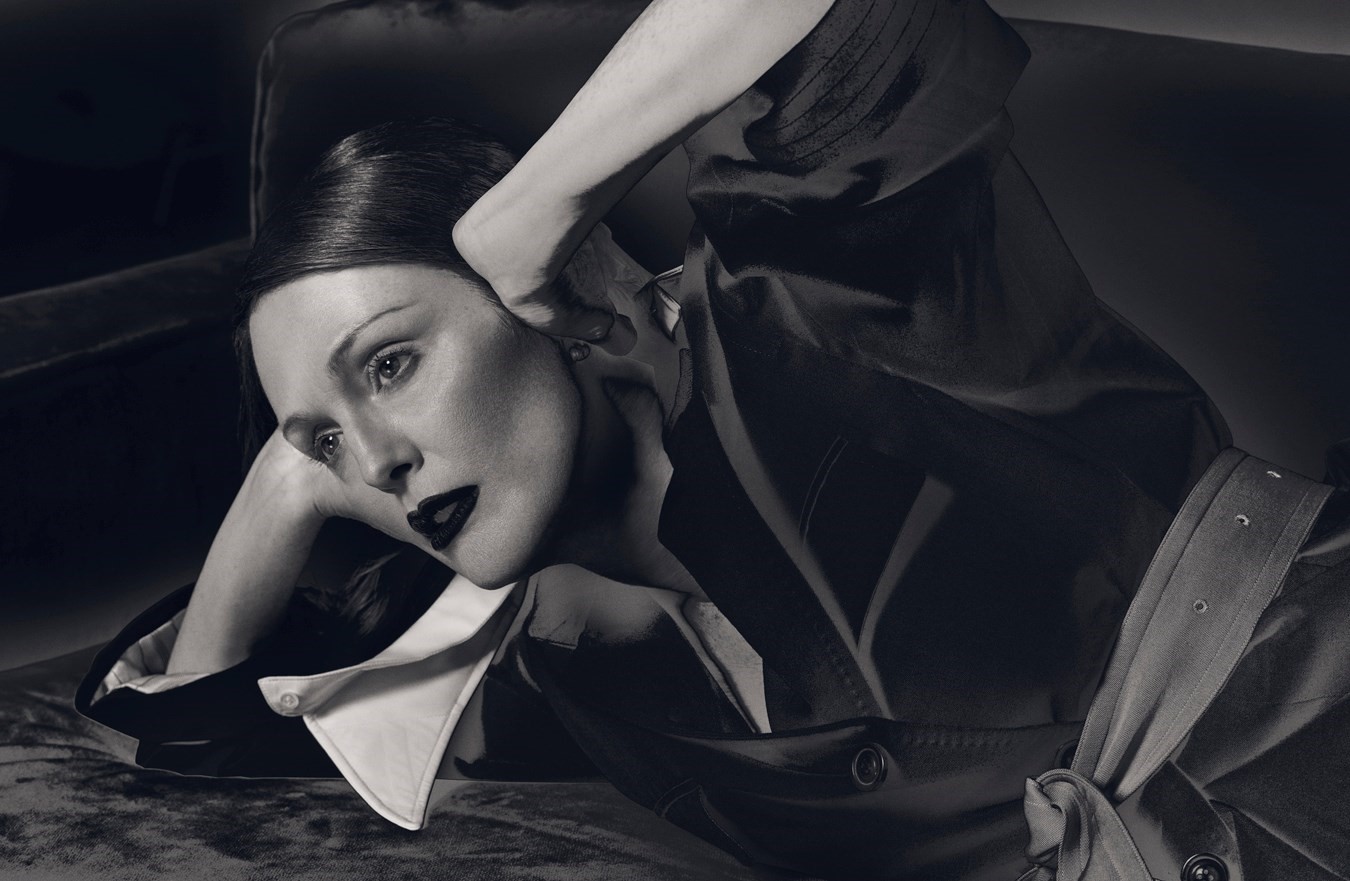
Back then, perhaps as a result of hitting stardom in her thirties, Moore swerved the ingenue film roles reserved for newcomers and dived straight into a slew of risky, heavy-weight material with original thinkers whose work was as fearless as she was. “It felt like this explosion of creativity,” she says of the golden era of Nineties indies. “The bar was low – we didn’t have to make huge box office numbers. It was a lot of new, young voices making stories they cared passionately about. When I look back, I think, ‘Holy cow, that was an amazing decade – what insane, adventurous work.’” Case in point: at a party in LA in 1995, Paul Thomas Anderson handed her a script that hurtled through the sleazy, ramshackle adult film industry of Seventies San Fernando Valley. Unlike some actors, Moore had no reservations about the explicit subject matter of Boogie Nights and picked up her first Oscar nomination for a heart-bruising performance as the seasoned porn star Amber Waves, jangly and strung out in iridescent eye shadow. She’s the film’s compassionate spirit, even if she can’t get out of her own way. (Architects of their own tragedies are a Moore speciality.) “I loved that Paul created this really complicated person who’s adamant she’s a good mother. You zoom out and think, ‘I don’t know if she is responsible enough to take care of this kid’ – and it breaks your heart.”
If Amber and Rollergirl’s jittery bedroom coke binge became Anderson’s favourite scene of Boogie Nights, it was accomplished while Moore’s personal life was headed in a more felicitous direction. It was 1996 and she had just met her future husband, the director Bart Freundlich, on his drama of New England family dysfunction, The Myth of Fingerprints. (He told Moore he cast her because she had a duality that made her look completely different when she smiled, which is exactly right and got her attention.) By the time she shot the Coen brothers’ stoned LA noir The Big Lebowski the next year, she was expecting her first child, Caleb – she didn’t tell the crew in case they tried to stop her ziplining nude across the set as Maude, the deadpan maker of “strongly vaginal” art. Maude’s comically affected Swiss finishing school accent was all Moore’s idea and the character became so quotable her lines even turn up on Beyoncé’s single Partition. These days at the annual Lebowski Fest, inaugurated in Kentucky, white Russian-drinking fans of all genders arrive in Maude’s strict bob, Viking hat and golden bowling-ball bustier.

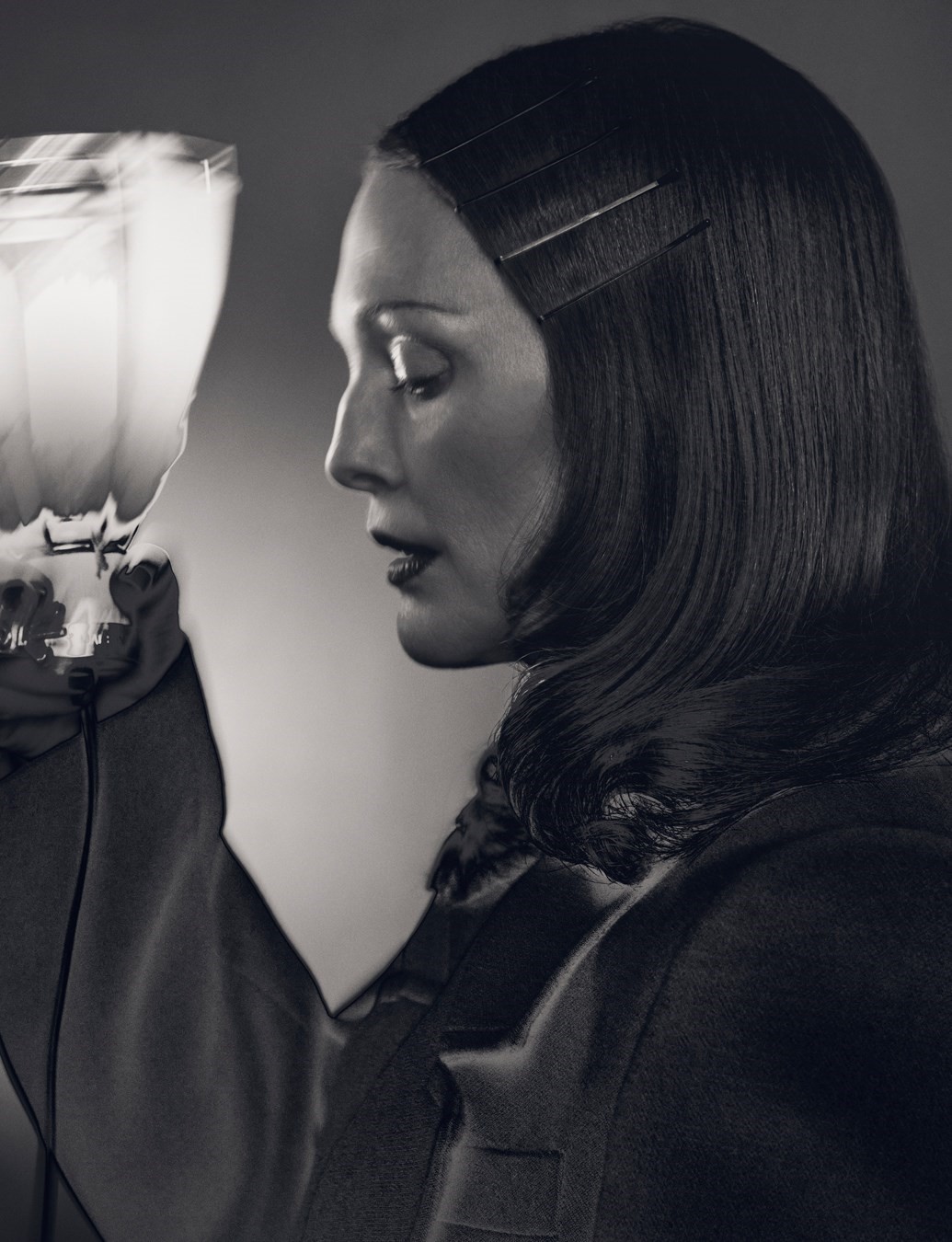
Moore’s flair for humour – see also her slightly goofy lesbian mom embroiled in an affair with her sperm donor in Cholodenko’s The Kids Are All Right – has sometimes been overlooked because she is so devastatingly adept at its opposite. It was the second, operatic role Anderson wrote for her that fixed Moore’s reputation as a wellspring of unfiltered vulnerability and pain. In his 1999 fever dream Magnolia, set in a San Fernando Valley populated with genius quiz kids and hangdog cops, entertainment tycoons and televangelists, Moore’s amphetamine-addicted trophy wife is a cyclone of neuroses and pent-up anxiety. Her expletive-packed melt-down in a pharmacy was pulled off in a couple of takes but has become as memed and memorable as the film’s biblical climax in which giant frogs rain down on all the sinful parents and their royally messed-up children. “It only happens if you’re relaxed,” she says simply of her unrivalled ability to mine fury and sorrow. “That’s when my work is the best. And then hopefully you can have an experience as that character,” she fixes me with her gold-green eyes. “God, this is so actor-y.”
Which is to say, if Moore has always taken her work seriously, she takes herself much less so. There’s no entourage today – she arrives alone and on time, breaking into that inimitable, disarming laugh when she discovers we’re both wearing Santa-red sweaters – her hair is tucked into hers, which feels like a subtle way to hide in plain sight amid the chattering New Yorkers around us. Moore is uncommonly easy to talk to; she doesn’t inflict silences and asks questions of her own – many more than are usual at her pay grade. If journalists are sometimes perplexed by the gulf between the roles she’s drawn to on the frayed edges and her down-to-earth demeanour (right now she’s looking forward to a family outing to see the musical comedy Merrily We Roll Along), for Moore that is precisely the point: to save the drama for the moment she hears “action”. She’s fond of Flaubert’s dictum, “Be regular and orderly in your life, so that you may be violent and original in your work.” Not that she isn’t outspoken – she has used her profile to support Planned Parenthood and LGBTQIA+ rights and is the co-founder of the gun control pressure group Everytown Creative Council. But on set she’s known for an uncanny ability to slip seamlessly from musings about the day’s lunch menu to gale force 9 breakdown on camera, no method or meditation required. Among her peers it seems generally agreed that she is the precise opposite of Havana Segrand, the petulant, self-absorbed sociopath she played (and won the best actress award at Cannes for) in David Cronenberg’s poison-pen letter to Hollywood, Maps to the Stars. Unlike that Rodeo Drive-shopping Norma Desmond with blonde extensions, Moore has navigated the snakes and ladders of the business with grace. “I don’t work well if I’m in an antagonistic or a distant environment. It would be a hindrance,” she says. “I want to be close to the people I’m working with – we’re creating this together. I want to have access to them and I want them to have access to me.”
“I learnt that behaviour is not character, behaviour is mutable. Behaviour is sometimes culture, and language can even inform it. Once you know that, you look for the universality in behaviour and realise all these other things are signifiers” – Julianne Moore
Moore traces her chameleon gift for disappearing into new identities, her ear for the idiosyncrasies of accent, to an unusually transient childhood. She was born with the less-starry name Julie Anne Smith at a military base in North Carolina, in 1960 – her father was a paratrooper who won a Purple Heart in Vietnam. As he rose through the ranks from helicopter pilot to lawyer and later military judge, the family crisscrossed the United States from Nebraska to Texas, Alaska to Alabama, in his wake. Moore and her two younger siblings went to nine different schools, becoming adept at the reinvention and shapeshifting required to be the perennial new kid in town. “So many actors I know had these weird itinerant childhoods,” she says. “You learn to observe people and how to adapt. You’re always trying to figure out where you fit in – how to behave, how to speak, what are the codes? I learnt that behaviour is not character, behaviour is mutable. Behaviour is sometimes culture, and language can even inform it. Once you know that, you look for the universality in behaviour and realise all these other things are signifiers.”
Moore’s mother was Scottish, emigrating with her parents from Greenock, a rainy port town beside the waters of the Firth of Clyde where her father was a shipbuilder, to New Jersey when she was a child. They cultivated a little piece of Scotland in the garden there, complete with deer statue, birdbath and a trellis of roses. Moore’s parents met at church and married young. “They were very self-propelled, both the first in their families to put themselves through college and graduate school,” she says. Her mother jigsawed together three degrees while moving 23 times and raising three children, eventually becoming a psychiatric social worker, a profession that resulted in dinner-table debate tackling knotty issues around why we do what we do – rich fodder for a nascent actor. Along with her Celtic colouring – Moore’s school nickname was Freckleface Strawberry, a moniker she reclaimed with her children’s books of the same name – Moore’s mother passed along a love of reading. “If you’re new in town and don’t know anybody, you spend the summer in the library,” she says. “Louisa May Alcott, Laura Ingalls Wilder, Henry James, F Scott Fitzgerald. I’d read anything, I loved the sensation of being inside a story.” When she discovered the drama department it felt like walking into one of her favourite books. “It was a refuge. I wasn’t sporty at all. I would try out for cheerleading or the drill team and never make it. So the last resort was drama, with all the losers,” she says with a laugh. Her first role was “the red-haired girl” in a Charlie Brown musical – a non-speaking part that required her to sit on a bench and eat a sandwich, though her mouth was so dry from nerves she could barely swallow. Speaking roles followed but drama was always the understudy to her aspirations to become a doctor, until she moved to Frankfurt aged 16. “My English teacher was putting on Tartuffe! I’d never heard of Molière! After we did it she said, ‘I think you could do this for a living.’ People in movies felt so distant to me but I realised it was this thing I could do.” It was her teacher’s advice to hit New York, check into a hostel and start auditioning, much to the unease of Moore’s parents. Boston University’s fine arts programme was the compromise they landed on, and at 18 Moore took off for the East Coast, working evening shifts as a cocktail waitress to help fund her studies.
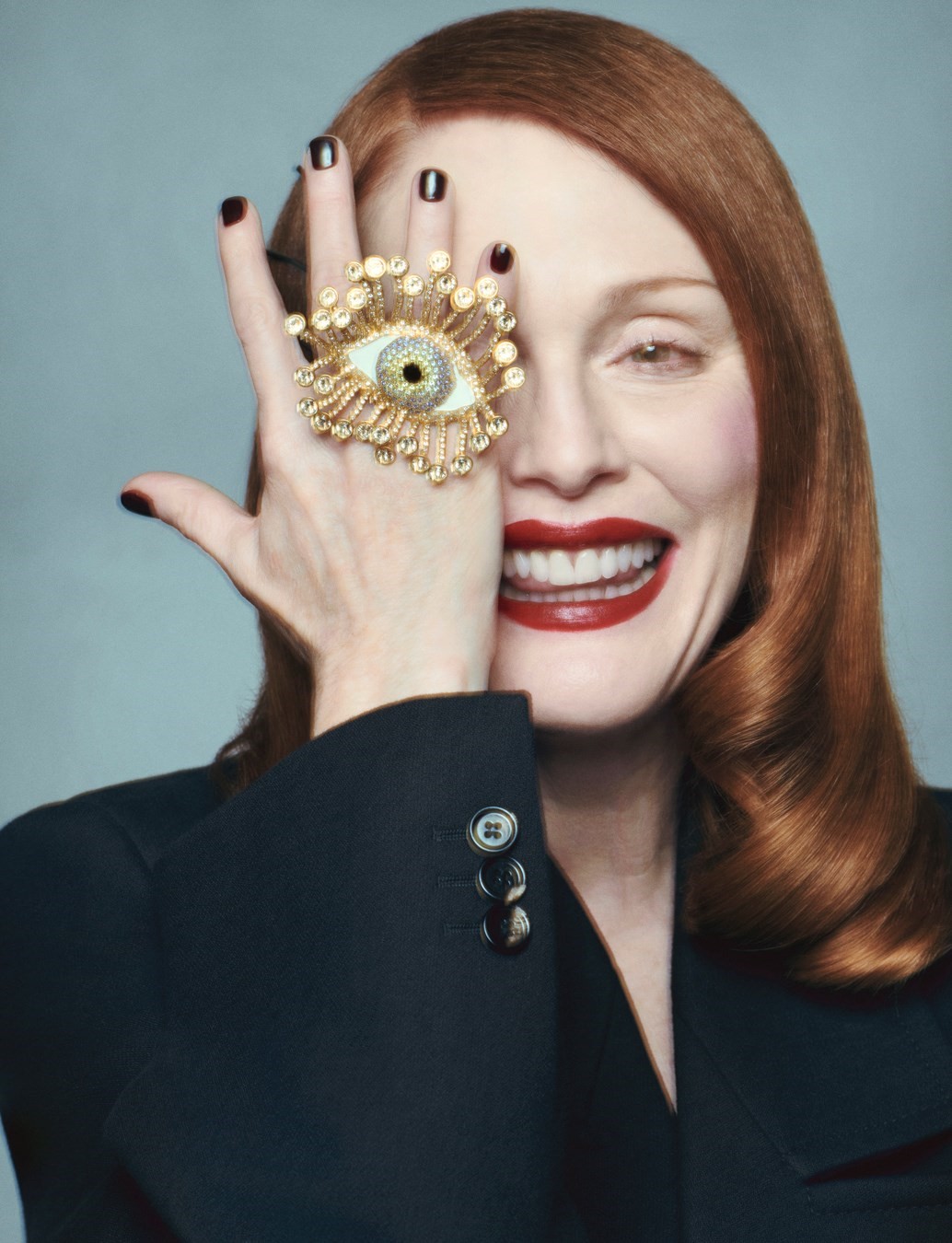
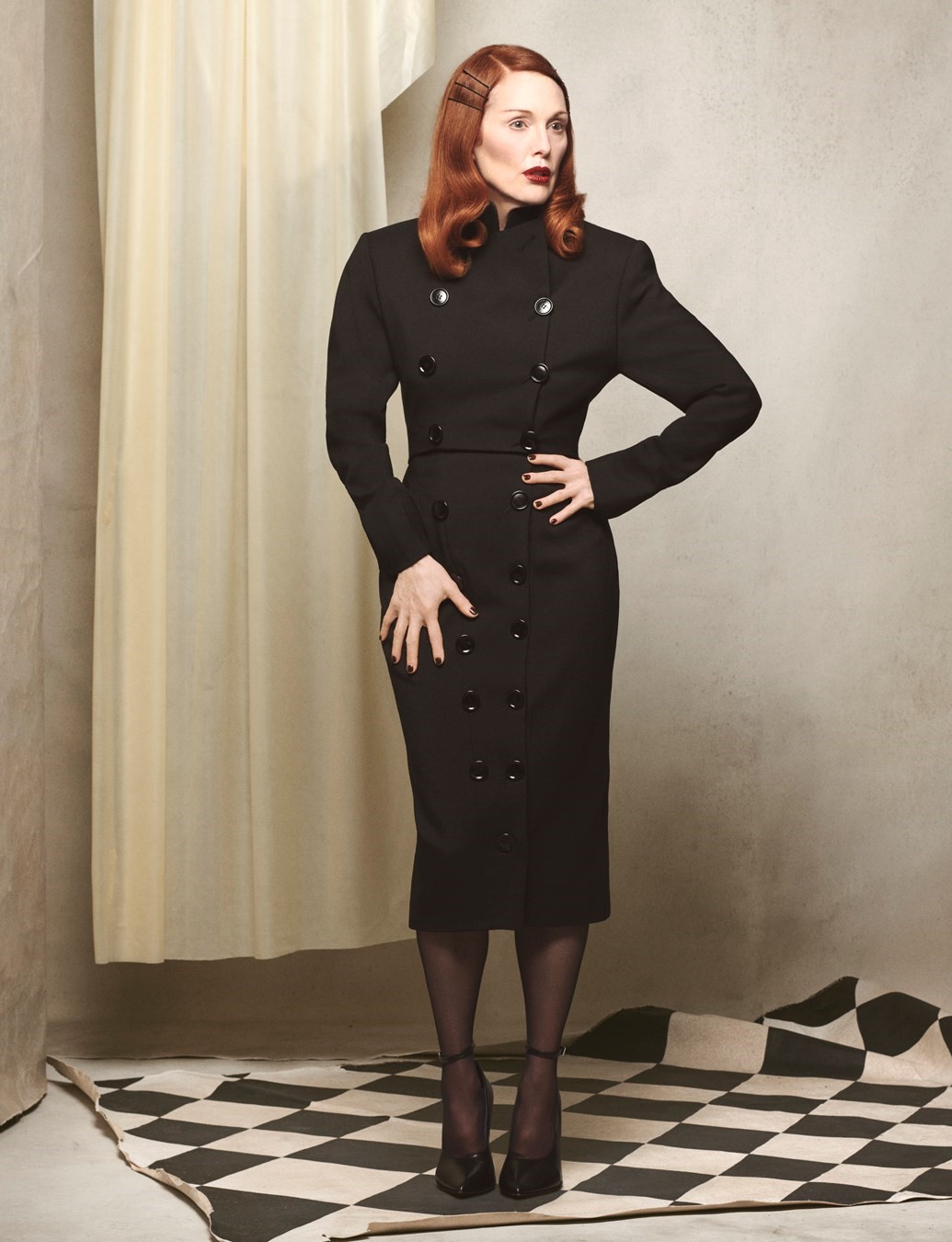
If there’s a thread to her kaleidoscopic range since, it’s that the actor has demanded our attention on lives traditionally relegated by Hollywood to the edge of the frame. If she isn’t sent that material she seeks it out, as in 2017 when Moore contacted the Chilean director Sebastián Lelio and then exec-produced the film they made together, Gloria Bell, featuring that vanishingly rare protagonist, a single fiftysomething woman with glasses and a job in insurance. Moore’s free-spirited turn brought tender realism and humour to the role, not to mention unglamorous sex of the kind people rarely have in “the movies”. (Moore is unhampered by vanity and has always understood we come to see ourselves, not a famous person, on screen.) In Tom Ford’s A Single Man she gave a dignified charm to her lonely, Santa Monica Canyon divorcee, elegantly sozzled on Tanqueray gin with winged eyeliner and a pink Sobranie. And two of her five Oscar nominations have sprung from portraying Fifties housewives at odds with their airless suburban lives: in Haynes’s lush Far from Heaven she maintains a flawless façade over a thundercloud of anguish, refilling her guests’ daiquiris until her pristine world falls apart; in Stephen Daldry’s The Hours she plasters sunny normalcy over brackish tides of depression. But the long overdue Academy Award came for 2014’s Still Alice, as a hyper-articulate Upper West Side professor confronting the creeping fog of Alzheimer’s, acutely aware her pin-sharp mind is slipping away. Moore consulted Alzheimer’s patients and neurologists and went to support groups and long-term care facilities to conjure her wrenching portrayal of a person never more cognisant of life than when facing the loss of it. There wasn’t a dissenter in the house when she picked up her Oscar from Matthew McConaughey in 2015, wearing a Chanel dress embroidered with 80,000 sequins. “I wore a cardigan to the premiere of Boogie Nights!” she says of the days when red carpets had a little more latitude.
The statuette now sits at the back of a bookshelf in her idyllic cedar-clad home in end-of-the-line Montauk, shared with Freundlich and their lockdown-adopted lab mix, Hope. Outside there’s a modernist pool, a wildflower meadow, a vegetable garden and ocean views – Moore sometimes learns her lines walking the rocky shore. For many years she and Freundlich lived in a West Village townhouse filled with children and dogs – she married him, in a lilac Prada dress, in its back garden in 2003. Perhaps because of that peripatetic childhood, Moore emphasised stability for her own children – she did the school runs, chose projects that wouldn’t drag her far from home, and sometimes drafted the kids in as extras for maximum family time. But on screen, her depictions of motherhood have taken that often-hackneyed role into much less stable, tough and complicated territory, unpicking taboos and jolting us out of safe assumptions. There’s the volatile rock musician in What Maisie Knew, trying yet failing to show up for her daughter. And the social-climbing, Cadaqués-holidaying heiress to the Bakelite millions in Savage Grace, who initiates an incestuous relationship with her son before he stabs her to death with a kitchen knife.
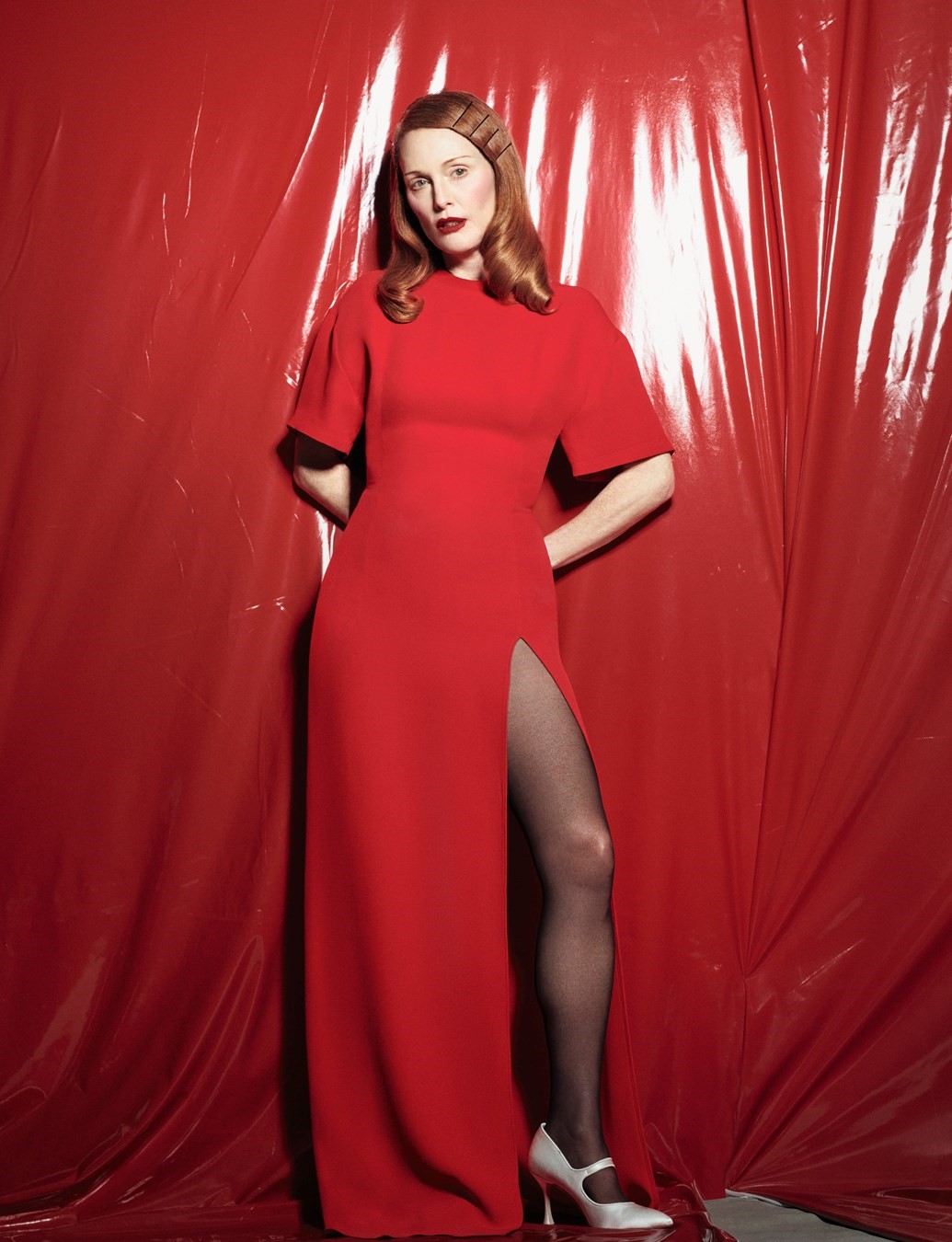
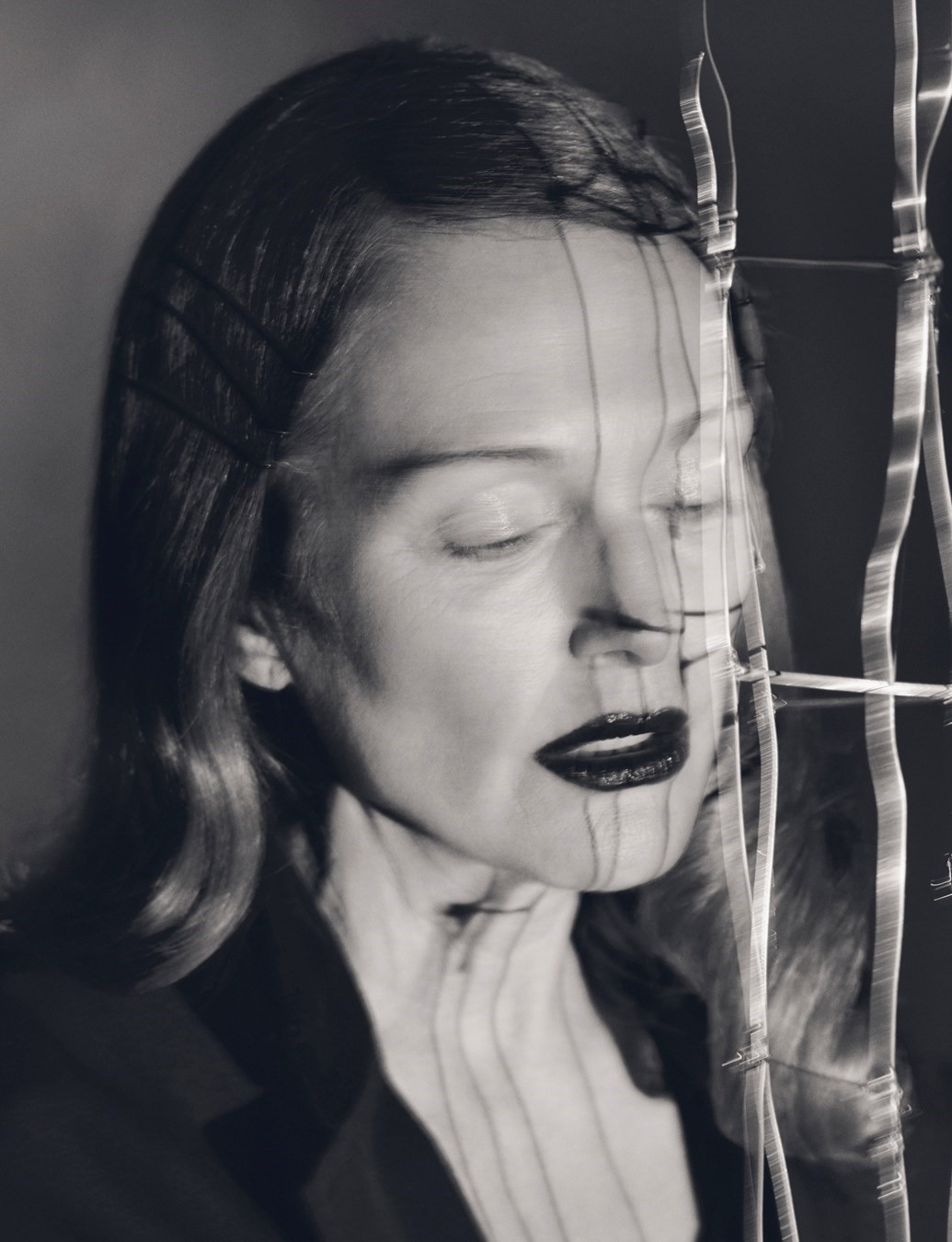
In Moore’s seventh decade, her choices are becoming no less radical. This year sees her as another social climber, in the series Mary & George, a tale of Jacobean skulduggery based on the ruthless bisexual countess Mary Villiers, who rose through snarls of conflicting interests in the English court by engineering her son’s affair with King James I. Mary swears like a sailor, hangs out in brothels and dispatches the competition with poisoned prunes, her hairstyles growing ever larger with her correspondent power. Then there’s an adaptation of Margaret Atwood’s wickedly dark revenge story Stone Mattress with the equally convention-defying Lynne Ramsay. It’s no wonder Moore politely declines to pick one of her 80 film roles for special mention: she is not an actor who needs to look back. Moore is thoroughly engaged with her full-bodied present. In a business where options for women seem to narrow with every birthday, she continues to show us the full spectrum of experience, dynamiting stereotypes and reshaping our screen vocabulary for the better. And if she has built a home life as steady as an A-lister’s can hope to be, on set she can still feel the white-knuckle thrill of the first day. “Oh yeah – because the margin of error is so wide. You never know what it’s going to be like, because we’re pretending! We’re building this stuff out of the air!” She pauses, trying to put her finger on the sensation. “It’s like I experience a blackout when I’m working. I do all this preparation, then you do it and it turns to dust. And I never really remember what I did. Because it takes a sense of being in the present to make it alive.” In those moments, some mysterious combination of left and right brain – the colossal imagination she’s able to unleash joined with the rigorous mind that tethers it – makes her as riveting to watch folding laundry as she is unravelling spectacularly. If it’s hard to imagine there was a time when Moore couldn’t get a film, today it’s harder to imagine that we’ll ever tire of watching her.
Hair: Esther Langham at Art + Commerce using ORIBE. Make-up: Mark Carrasquillo at R3-MGMT using SHISEIDO. Manicure: Megumi Yamamoto at Susan Price using Le Vernis by CHANEL. Set design: Griffin Stoddard at Streeters. Digital tech: Nicholas Ong. Photographic assistants: Shri Prasham Parameshwaran, Nick Krasznai and Tony Jarum. Styling assistants: Precious Greham and Candace Sutton. Tailor: Hailey Desjardins. Hair assistant: Ginger Ryan. Make-up assistant: Mika Omura. Set co-ordinator: Grace Beck. Set dresser: Raph Fineberg. Production: Gracey Connelly. Production assistant: Chris Cassetti. Post-production: Gloss
All seven episodes of Mary & George will launch on Sky Atlantic and NOW on 5 March 2024.
This story features in the Spring/Summer 2024 issue of AnOther Magazine, which is on sale internationally on 29 February 2024. Pre-order here.
